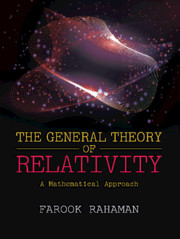Book contents
- Frontmatter
- Dedication
- Contents
- List of Figures
- List of Tables
- Preface
- Acknowledgments
- Chapter 1 Tensor Calculus — A Brief Overview
- Chapter 2 Geodesic
- Chapter 3 Einstein Field Equations
- Chapter 4 Linearized Gravity
- Chapter 5 Lie Derivatives and Killing’s Equation
- Chapter 6 Spacetimes of Spherically Symmetric Distribution of Matter and Black Holes
- Chapter 7 Particle and Photon Orbits in the Schwarzschild Spacetime
- Chapter 8 Causal Structure of Spacetime
- Chapter 9 Exact Solutions of Einstein Equations and Their Causal Structures
- Chapter 10 Rotating Black Holes
- Chapter 11 Elementary Cosmology
- Chapter 12 Elementary Astrophysics
- Appendix A Extrinsic Curvature or Second Fundamental Form
- Appendix B Lagrangian Formulation of General Relativity
- Appendix C 3+1 Decomposition
- Bibliography
- Index
Chapter 11 - Elementary Cosmology
Published online by Cambridge University Press: 24 March 2021
- Frontmatter
- Dedication
- Contents
- List of Figures
- List of Tables
- Preface
- Acknowledgments
- Chapter 1 Tensor Calculus — A Brief Overview
- Chapter 2 Geodesic
- Chapter 3 Einstein Field Equations
- Chapter 4 Linearized Gravity
- Chapter 5 Lie Derivatives and Killing’s Equation
- Chapter 6 Spacetimes of Spherically Symmetric Distribution of Matter and Black Holes
- Chapter 7 Particle and Photon Orbits in the Schwarzschild Spacetime
- Chapter 8 Causal Structure of Spacetime
- Chapter 9 Exact Solutions of Einstein Equations and Their Causal Structures
- Chapter 10 Rotating Black Holes
- Chapter 11 Elementary Cosmology
- Chapter 12 Elementary Astrophysics
- Appendix A Extrinsic Curvature or Second Fundamental Form
- Appendix B Lagrangian Formulation of General Relativity
- Appendix C 3+1 Decomposition
- Bibliography
- Index
Summary
Introduction
Cosmology is the study of the universe as a whole. That means cosmology deals with the structure and evolution of the universe on the largest scales of space and time. Gravity plays the central role for the structure of the universe on these scales and regulates its evolution. Thus, general relativity is the main part of cosmological study and cosmology is one of the most important applications of general relativity. The universe consists of stars, gases, collections of matter (with zero rest mass or massive particles) with known and unknown characters and vacuum energy.
Note 11.1
Zero rest mass particles (photons, gravitons, etc.) are referred to as radiation and nonzero rest mass particles (protons, neutrons, electrons, etc.) are called matter. It is argued that protons and neutrons are built through more fundamental particles dubbed as quarks. The general terms for particles made up of these quarks are baryons. The neutrinos are extremely weak interacting particles, which are created, e.g., in radioactive decay. Neutrinos with very small masses behave approximately like radiation in some circumstances and matter in others.
The visible matter in the universe is mostly contained in galaxies—gravitationally bound collections of stars, gas, and dust. A typical galaxy has about 1011 stars and a total mass of 1012 times of solar mass, i.e., = 1012M⊙. In the observable universe, very roughly 1011 galaxies are seen. Assuming the visible matter in the galaxies is smoothed and uniformly distributed over the largest scales, then at the present day the density is approximately estimated as
which is equivalent to one proton per cubic meter.
Apart from galaxies, the universe comprises of radiation consisting of zero rest mass particles—photons and also some Newtonian and gravitational waves. The velocity of this radiation is similar to the velocity of light. The radiation is not gravitationally bound, clustered; that moves up the galaxies. Detected electromagnetic radiation that has been left-over from the hot big bang, with the greatest energy density, is the cosmic background radiation. To remarkable experimental precision, this is very similar to the black body spectrum with the temperature of 2.725 ± .001 K.
- Type
- Chapter
- Information
- The General Theory of RelativityA Mathematical Approach, pp. 305 - 344Publisher: Cambridge University PressPrint publication year: 2021



